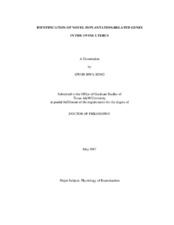| dc.description.abstract | The peri-implantation period in mammals is critical with respect to survival of
the conceptus and establishment of pregnancy. During this period of pregnancy,
reciprocal communication between ovary, conceptus, and endometrium is required for
successful implantation and placentation. Therefore, studies were conducted to indentify
and characterize novel endometrial genes important for implantation and conceptus
development in the ovine uterus.
The first and second studies defined the uterine expression of seven members of
the cathepsin (CTS) family of lysosomal proteases, and a secreted inhibitor of CTSL
called cystatin C (CST3) during the peri-implantation period. In addition, regulation of
CTS and CST3 by progesterone (P4) and interferon tau (IFNT) was evaluated. CTSL
was the most abundant CTS in the ovine ovine uterus and was also coordinately
expressed with CST3 in the endometrial epithelia and conceptus trophectoderm. CTSL
and CST3 were found to be novel P4-induced and IFNT-stimulated genes in the luminal
epithelial cells of the ovine endometrium.
The third study identified radical S-adenosyl methionine domain containing 2
(RSAD2) and interferon-induced with helicase C domain 1 (IFIH1) in the ovine uterus.
Results of this study indicated that IFNT induces RSAD2 and IFIH1 in a P4-independent
manner in the stroma, immune cells, and glands of the ovine endometrium. These two
genes are proposed to have biological roles in the establishment of uterine receptivity to
the conceptus during implantation.
The fourth study characterized endometrial expression of stanniocalcins (STC)
during pregnancy. STC1 appeared in the endometrial glands on Day 18 of pregnancy, increased from Days 18 to 80, and remained abundant through Day 120 of gestation. In
addition, this study demonstrated that STC1 is induced by P4 and increased by placental
hormones, such as placental lactogen (CSH1) and growth hormone (GH), in the ovine
endometrial glands.
Collectively, these studies identified genes that are expected to be critical to
unraveling the mechanism(s) of reciprocal fetal-maternal interactions required for
successful implantation and pregnancy. A more complete understanding of these genes
will be important for developing therapeutic strategies to prevent, treat and/or diagnose
infertility in domestic animals and humans, because they are biomarkers of P4 and/or
IFN effects. | en |


